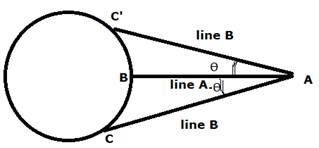In Ampere’s law ![]() the current outside the curve is not included on the right hand side. Does it mean that the magnetic field B calculated by using Ampere’s law, gives the contribution of only the currents crossing the area bounded by the curve?
the current outside the curve is not included on the right hand side. Does it mean that the magnetic field B calculated by using Ampere’s law, gives the contribution of only the currents crossing the area bounded by the curve?
The contribution to the magnetic field B by currents outside the Amperian loop turns out to be zero because if we draw a straight line on any fixed point on the loop from the current vector(the direction vector of current), let line A and draw another line from the current vector to a movable point on the loop, let line B, and move that point in one direction along the loop until the full loop is traversed then we can see the net positive angle travelled by line B with respect to line A is equal to the net negative value travelled by the same. So the total angle travelled is zero. The line integral has a finite value for a current that is within the loop as it traverses an angle of 2ϖ. So, we can say that Ampere’s law takes into account every current be it inside the Amperian loop/curve or outside but as for outside currents, the integral is zero, so only the enclosed current is taken into account for calculation but actually takes into consideration the contribution of all the currents.

we consider the circle to be the Amperian loop. Point B is the fixed point C is the moving point. At some point of time C coincides with C’ where ∠BAC = -∠BAC’. We will get a point like this for every arbitrary point on the circle, so total angle for all the circle will be zero as stated before.